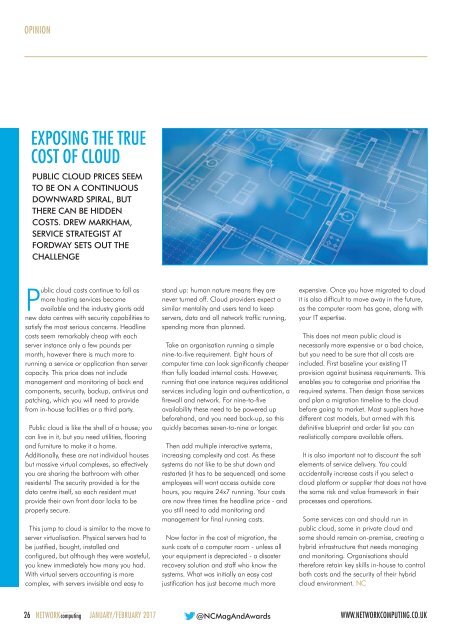NC1701
You also want an ePaper? Increase the reach of your titles
YUMPU automatically turns print PDFs into web optimized ePapers that Google loves.
OPINION<br />
EXPOSING THE TRUE<br />
COST OF CLOUD<br />
PUBLIC CLOUD PRICES SEEM<br />
TO BE ON A CONTINUOUS<br />
DOWNWARD SPIRAL, BUT<br />
THERE CAN BE HIDDEN<br />
COSTS. DREW MARKHAM,<br />
SERVICE STRATEGIST AT<br />
FORDWAY SETS OUT THE<br />
CHALLENGE<br />
Public cloud costs continue to fall as<br />
more hosting services become<br />
available and the industry giants add<br />
new data centres with security capabilities to<br />
satisfy the most serious concerns. Headline<br />
costs seem remarkably cheap with each<br />
server instance only a few pounds per<br />
month, however there is much more to<br />
running a service or application than server<br />
capacity. This price does not include<br />
management and monitoring of back end<br />
components, security, backup, antivirus and<br />
patching, which you will need to provide<br />
from in-house facilities or a third party.<br />
Public cloud is like the shell of a house; you<br />
can live in it, but you need utilities, flooring<br />
and furniture to make it a home.<br />
Additionally, these are not individual houses<br />
but massive virtual complexes, so effectively<br />
you are sharing the bathroom with other<br />
residents! The security provided is for the<br />
data centre itself, so each resident must<br />
provide their own front door locks to be<br />
properly secure.<br />
This jump to cloud is similar to the move to<br />
server virtualisation. Physical servers had to<br />
be justified, bought, installed and<br />
configured, but although they were wasteful,<br />
you knew immediately how many you had.<br />
With virtual servers accounting is more<br />
complex, with servers invisible and easy to<br />
stand up: human nature means they are<br />
never turned off. Cloud providers expect a<br />
similar mentality and users tend to keep<br />
servers, data and all network traffic running,<br />
spending more than planned.<br />
Take an organisation running a simple<br />
nine-to-five requirement. Eight hours of<br />
computer time can look significantly cheaper<br />
than fully loaded internal costs. However,<br />
running that one instance requires additional<br />
services including login and authentication, a<br />
firewall and network. For nine-to-five<br />
availability these need to be powered up<br />
beforehand, and you need back-up, so this<br />
quickly becomes seven-to-nine or longer.<br />
Then add multiple interactive systems,<br />
increasing complexity and cost. As these<br />
systems do not like to be shut down and<br />
restarted (it has to be sequenced) and some<br />
employees will want access outside core<br />
hours, you require 24x7 running. Your costs<br />
are now three times the headline price - and<br />
you still need to add monitoring and<br />
management for final running costs.<br />
Now factor in the cost of migration, the<br />
sunk costs of a computer room - unless all<br />
your equipment is depreciated - a disaster<br />
recovery solution and staff who know the<br />
systems. What was initially an easy cost<br />
justification has just become much more<br />
expensive. Once you have migrated to cloud<br />
it is also difficult to move away in the future,<br />
as the computer room has gone, along with<br />
your IT expertise.<br />
This does not mean public cloud is<br />
necessarily more expensive or a bad choice,<br />
but you need to be sure that all costs are<br />
included. First baseline your existing IT<br />
provision against business requirements. This<br />
enables you to categorise and prioritise the<br />
required systems. Then design those services<br />
and plan a migration timeline to the cloud<br />
before going to market. Most suppliers have<br />
different cost models, but armed with this<br />
definitive blueprint and order list you can<br />
realistically compare available offers.<br />
It is also important not to discount the soft<br />
elements of service delivery. You could<br />
accidentally increase costs if you select a<br />
cloud platform or supplier that does not have<br />
the same risk and value framework in their<br />
processes and operations.<br />
Some services can and should run in<br />
public cloud, some in private cloud and<br />
some should remain on-premise, creating a<br />
hybrid infrastructure that needs managing<br />
and monitoring. Organisations should<br />
therefore retain key skills in-house to control<br />
both costs and the security of their hybrid<br />
cloud environment. NC<br />
26 NETWORKcomputing JANUARY/FEBRUARY 2017 @NCMagAndAwards<br />
WWW.NETWORKCOMPUTING.CO.UK

















